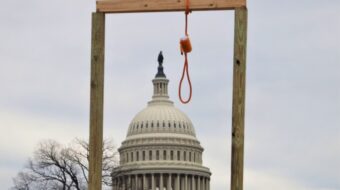
[Editor’s note: Peoplesworld.org received the following appreciation and unique tribute to author and activist Phillip Bonosky from a “discerning reader” and library worker in Pittsburgh. We reprint it here with the author’s permission.]
Dear People’s World and Daniel Rosenberg:
Many thanks for printing the obituary on Phillip Bonosky.
I’ve spent the past few weeks, maybe even a month now, spending valuable and sleep-deprived time with Phillip Bonosky’s (last?) novel, The Magic Fern.
I was taking a break from reading said novel this evening when I decided — or at least found myself — meandering about the interwebs, and stumbled upon the news of his death.
I first read his (earlier) novel, Burning Valley, in college – a requirement for a class on “working class literature.” The novel was available for assignment because it had been brought back into print by the University of Illinois Press as part of their “Radical Novel reconsidered” series (with a declared focus on the post-WWII proletarian novels — a unique genre, if anyone is familiar with the proletarian artistic movement which reached a high point in the 1930s — Steinbeck, Lynd Ward, Michael Gold, WPA-funded murals, etc., inspired by radical movements in Latin America and Europe; and by the 1950s — Cold War, McCarthy, Korea, “domino” theory of U.S. foreign policy — was unpopular to say the least, if not effectively dead…). This is, by the by, the only novel that I was introduced to by this particular class that had any effect on me. And I consider myself a fairly discerning reader (albeit, there’s no accounting for taste).
I re-read the novel last year, and, inspired, I convinced a very generously obliging co-worker at the Carnegie Library of Pittsburgh, where I am a library assistant, to purchase two copies for the fiction collection (the book was represented – by the main library – by one, off-site, reference copy). When we received our nice new copies, I wrote up Bonosky’s Burning Valley as my “staff pick,” which you can read here (scrolling down, down, down):
http://www.carnegielibrary.org/books/staffpicks/staff/miguel.html
It is a brilliant book.
After reading it this second time, I actually headed down to Duquesne to do what ended up to be a lot of misguided driving and walking about trying to find the setting of the novel. I spoke with a former resident of Duquesne who updated Bonosky’s novel a bit for me (gave me a far more current portrait of the City of Duquesne), and overall, my trip was a wasted day in that strict sense of not accomplishing the specific goal I set out for.
BUT — I managed to ask some old folk who were heading to evening services at a church if they knew of a hollow that’d been filled up (cf. the plot of the novel). After one man told me to hold on a minute and ran to grab an even older man … this second man told me I must be speaking of nickee – mickey – something along those lines – hollow. Long gone. Head down that-a-ways and you can see where it was. I headed down and didn’t see anything. Left Duquesne frustrated and what not… and hadn’t even heard clearly what name he had given the hollow-that-was-but-is-no-longer. Then, later, back at the ranch, and poring over one of those new Arcadia Publishing series books, the not-quite-heard name was clarified: “Nick Lee Hollow.” I subsequently contacted the Mifflin Township Historical Society, and they completed the picture (literally – sending me two photos of the nevermore hollow).
And now I’ve almost completed The Magic Fern, and I have definite plans to submit it for consideration of republication by the New York Review Books (reprinters extraordinaire; reprinted Attaway’s Blood on the Forge, the profound proletarian Pittsburgh Great Migration novel). Never have I read such brilliant lyricism mixed with the grit of everyday life. Burning Valley shows great skill, but the story is remarkably simple despite itself. It’s something like Van Gogh’s Starry Night. The Magic Fern is among the most dispassionate yet compassionate novels I have ever read, detailing the triumphs and tragedies of the unionization of steelworkers. It is a panorama of the Mon valley in the 1950s. It is much closer in spirit (continuing with the fine arts analogy) to Picasso’s Guernica. There beat many warm hearts throughout these pages; and despite Bonosky’s card-carrying politics, neither workers nor management are “white-washed.” Bonosky clearly prefers the side of the working wo/man, and while — perhaps — simplifying the potential complexity of the motivations of the wealthy mill owners and town politicians, he offers up no straw dogs, nor martyrs… just gray figures maneuvering through a gray world.
Bonosky surrounds you with his world and his vision: it sticks to your soul like the pollution of the works sticks to the throats and lungs of the residents of the bottoms. It moves with you; you become extremely conscious of swallowing. Bonosky only insists that, despite the smog and soot that hangs over industry and production and kills as it saves, a vision of right and wrong persists.
Morality is not subject to capital; that is Bonosky’s legacy.
I was appalled that his death passed seemingly completely unnoticed by the press.
All this is to say, that while I apologize for the length, then, of this email… I at least wanted to thank you for recalling the contributions of one of the greatest American writers of the 20th century, who happened to be born in, forever influenced by, and inspired to write of, southwestern Pennsylvania and its workers.
Sincerely,
Miguel
Photo: PW










